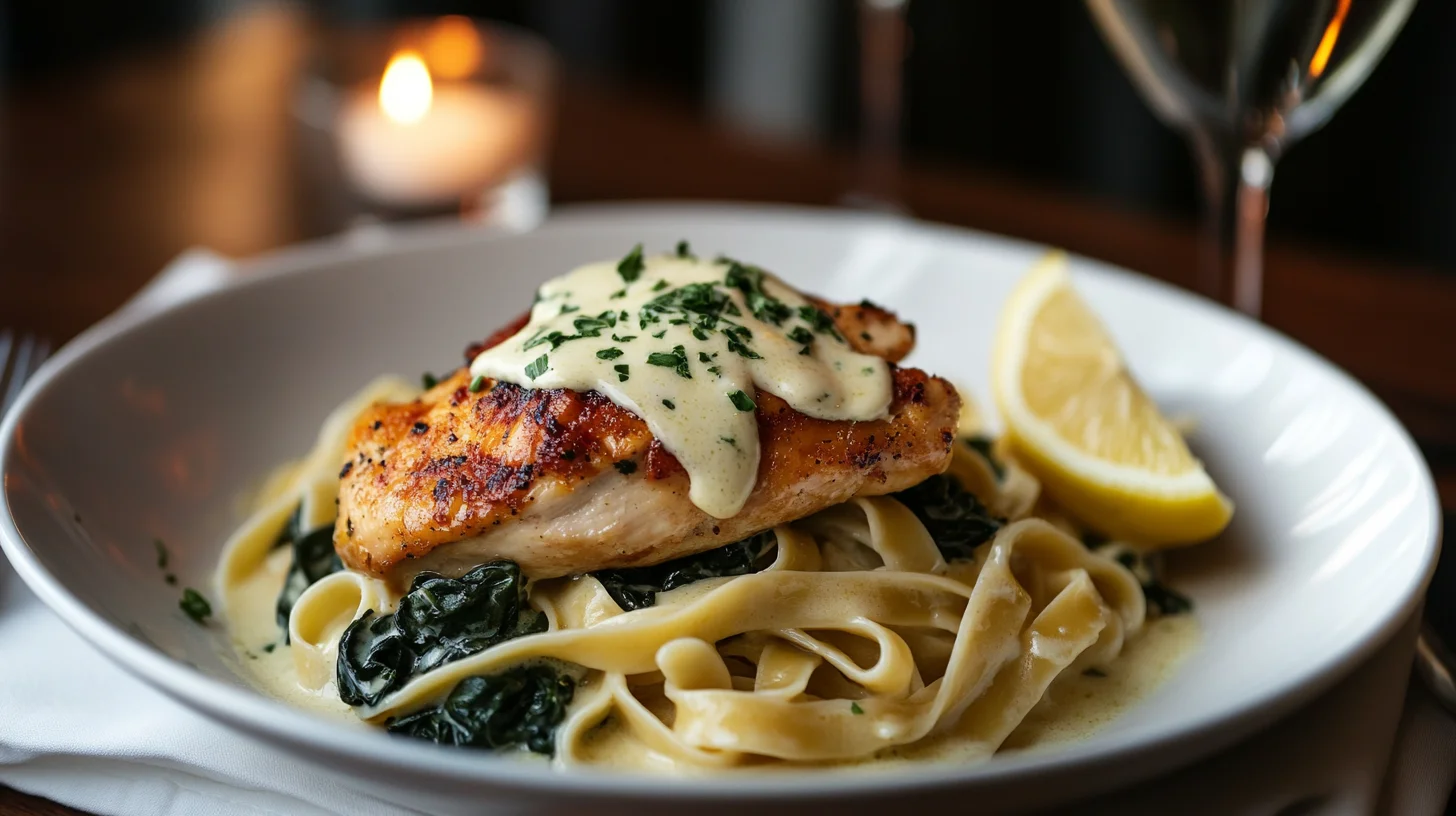There’s something undeniably comforting about a creamy, savory chicken dish bubbling away in your kitchen, filling the air with a rich, inviting aroma. One such classic that has stood the test of time is Creamy Chicken Florentine—a dish that blends tender chicken, velvety cream, and nutrient-rich spinach into one harmonious and mouth-watering meal. Whether you’re a seasoned home chef or a beginner eager to impress, this dish promises gourmet results without the hassle.
Creamy Chicken Florentine has earned its place on family dinner tables and upscale restaurant menus alike. It’s that perfect middle ground—simple enough for a weekday dinner, yet elegant enough to serve on special occasions. With its French-Italian roots and rich flavor profile, this creamy delight balances rustic charm with a touch of sophistication.
In this guide, we’ll dive deep into everything you need to know about Creamy Chicken Florentine. From its culinary origins and essential ingredients to pro-level cooking tips and modern twists, this article is your one-stop shop for mastering this iconic comfort food.
Let’s begin our journey into the world of creamy, spinach-laced goodness!
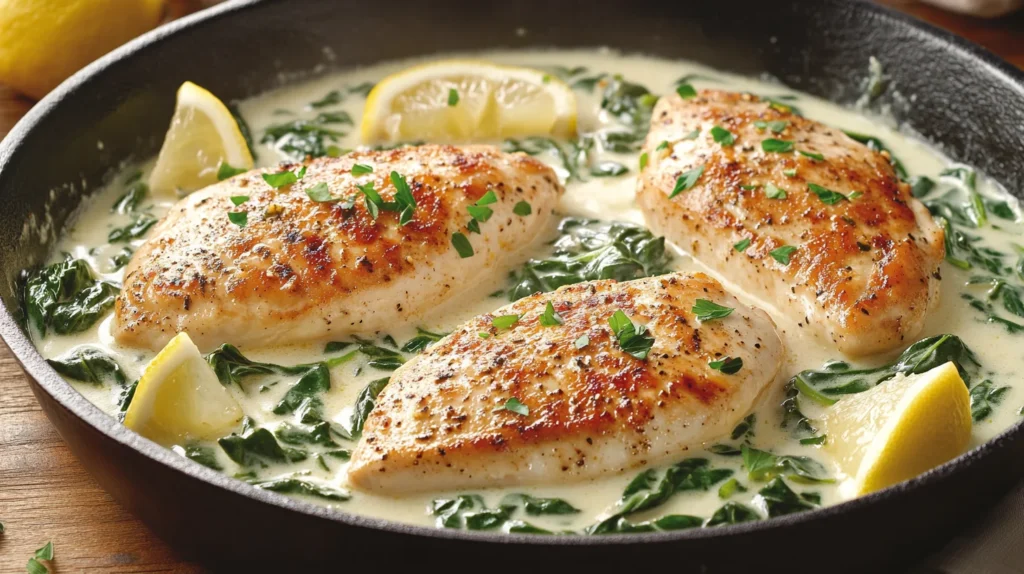
What is Creamy Chicken Florentine?
Creamy Chicken Florentine is a dish where tender chicken is pan-seared and then simmered in a luscious cream sauce infused with garlic, parmesan, and spinach. It’s known for its rich texture, vibrant color from the spinach, and delicate balance of flavors. The dish often includes wine or broth for added depth, and a splash of lemon juice to brighten up the creamy base.
While many creamy chicken dishes exist, Florentine stands out due to the use of spinach—a nod to its historical ties with Florence, Italy, which we’ll explore in more detail next.
Want something lighter for lunch? Try the quick and vibrant Apple Tuna Salad Recipe as a refreshing companion dish or starter.
The Meaning of “Creamy Chicken Florentine” in Cuisine
The term “Creamy Chicken Florentine” in culinary terms usually refers to dishes that include spinach as a primary ingredient. This tradition comes from Florence, Italy, where spinach has been a celebrated vegetable for centuries. Thanks to Catherine de Medici—a Florentine noblewoman who became Queen of France in the 16th century—spinach gained popularity in French cooking as well.
That’s why you’ll find dishes like eggs Florentine or fish Florentine, all of which highlight spinach as a key component. In the case of Chicken Florentine, the vibrant green leaves not only bring nutrients to the table but also a slightly earthy taste that complements the creamy sauce beautifully.
Creamy Chicken Florentine vs Other Creamy Chicken Dishes
While Creamy Chicken Florentine shares similarities with other creamy dishes like Chicken Alfredo or Tuscan Garlic Chicken, there are a few distinct differences.
- Spinach Inclusion: This is the defining characteristic of Florentine recipes.
- Lighter Sauce: Unlike Alfredo, which uses heavy cream and butter, Florentine sauce often combines cream with broth or wine, making it lighter.
- Lemon or Wine Kick: Many versions of Chicken Florentine add a splash of white wine or lemon juice to cut through the richness, offering a more balanced flavor profile.
That makes it ideal for those who love creamy dishes but want something slightly more nuanced and vegetable-forward.
Key Ingredients Breakdown Creamy Chicken Florentine
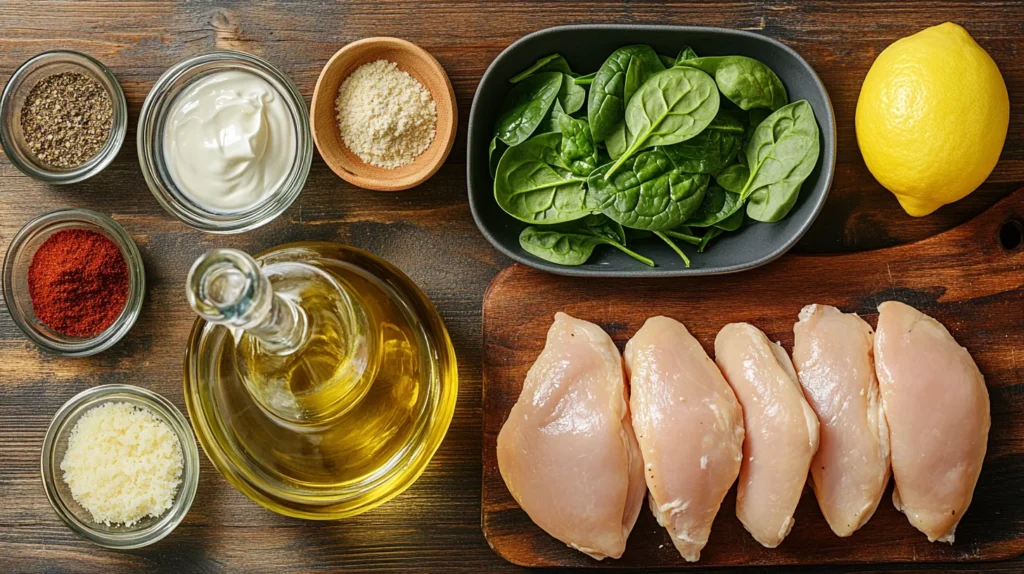
When it comes to making Creamy Chicken Florentine, the magic is in the ingredients. Each component plays a crucial role in shaping the dish’s flavor, texture, and overall experience. In this section, we’ll explore both the essential and optional ingredients that you can use to craft the perfect Chicken Florentine at home.
Boneless Chicken Breast or Thighs
Creamy Chicken Florentine is, of course, the star of this dish, and choosing the right cut can make all the difference. Most traditional recipes use boneless, skinless chicken breasts, which are lean and cook relatively quickly. However, chicken thighs are an excellent alternative if you prefer a juicier and more flavorful cut.
Pros and Cons of Creamy Chicken Florentine Breast
- Pros: Lower in fat, faster to cook, presents well when sliced.
- Cons: Can become dry if overcooked.
Pros and Cons of Creamy Chicken Florentine Thighs
- Pros: Juicier, more forgiving when cooking, rich flavor.
- Cons: Slightly longer cook time, more fat content.
Whichever cut you choose, make sure it’s fresh and of good quality, preferably organic or free-range for best flavor and texture.
Spinach: The Star of Creamy Chicken Florentine
If chicken is the backbone, spinach is the soul of Creamy Chicken Florentine. It gives the dish its identity and historical roots. Most recipes call for fresh baby spinach, which cooks quickly and blends seamlessly into the sauce.
Fresh vs. Frozen Spinach Creamy Chicken Florentine
- Fresh Spinach: Delicate flavor, better texture, quick to wilt. Needs to be rinsed and dried before cooking.
- Frozen Spinach: Convenient, economical, but must be thawed and well-drained to avoid watering down the sauce.
Adding spinach not only boosts the nutritional value but also introduces a pleasant earthiness and vibrant green color that makes the dish visually appealing.
Cream and Cheese
Here’s where the “Creamy Chicken Florentine” part really kicks in. A good Florentine sauce relies on a blend of heavy cream and cheese, typically Parmesan or Pecorino Romano, to achieve that silky, indulgent finish.
Choosing the Right Cream Creamy Chicken Florentine
- Heavy Cream (35%+ fat): Provides the richest, thickest sauce.
- Half-and-Half or Light Cream: Less fat, still creamy, better for lighter versions.
- Dairy-Free Alternatives: Coconut cream, almond milk with thickener, or cashew cream for vegan-friendly tweaks.
Best Cheeses to Use
- Parmesan Cheese: Nutty, salty, and melts smoothly.
- Pecorino Romano: Sharper and more intense, ideal for bold flavors.
- Cream Cheese (Optional): Adds body and tang, commonly used in American-style versions.
Cheese not only thickens the sauce but also adds umami depth that balances the spinach and chicken beautifully.
Aromatics and Flavor Enhancers Creamy Chicken Florentine
To give your dish that restaurant-quality taste, don’t forget these supporting stars:
- Garlic: A few cloves, minced or finely chopped, sautéed at the start to build flavor.
- Shallots or Onion: Optional, but adds a touch of sweetness.
- White Wine or Chicken Broth: Adds acidity and complexity to the sauce.
- Lemon Juice or Zest: Brightens the dish and cuts through richness.
- Salt, Pepper, and Nutmeg: Essential for seasoning. Nutmeg in particular complements spinach and cream.
Using these wisely ensures a layered, flavorful result that’s far from bland.
Optional Add-Ins Creamy Chicken Florentine
Depending on your taste or dietary needs, you can enhance the dish with a few optional extras:
- Mushrooms: Adds earthiness and texture.
- Sun-dried Tomatoes: Introduce sweetness and tang.
- Crushed Red Pepper: For a little heat.
- Fresh Herbs (Thyme, Basil, Parsley): Add fragrance and color at the end.
Don’t be afraid to experiment—Creamy Chicken Florentine is a flexible dish that welcomes creative tweaks while staying true to its classic roots.
Need a fast, flavorful sauce companion for chicken? Don’t miss the crowd-pleasing Pot BBQ Chicken method—it’s smoky, sweet, and a great alternative flavor profile.
Step-by-Step Recipe

Making Creamy Chicken Florentine from scratch may sound fancy, but it’s incredibly doable—even for beginners. The key lies in using fresh ingredients, managing your cooking heat, and building flavor at every step. Below, we’ll guide you through the full cooking process from prep to plate.
Preparation Time and Servings
Before we start, here’s a quick overview of what to expect.
| Prep Time | Cook Time | Total Time | Servings |
|---|---|---|---|
| 10 mins | 25 mins | 35 mins | 4 servings |
This makes it a fantastic weeknight dinner option—fast, flavorful, and family-friendly.
Ingredients You’ll Need
Here’s a basic list of what you’ll need to make a classic Creamy Chicken Florentine:
- 4 boneless, skinless chicken breasts (or thighs)
- 2 tablespoons olive oil
- Salt and black pepper to taste
- 3 cloves garlic, minced
- 1 cup heavy cream
- ½ cup grated Parmesan cheese
- 1 cup chicken broth (or dry white wine)
- 4 cups fresh baby spinach
- 1 tablespoon lemon juice
- 1 teaspoon Italian seasoning
- Optional: 1 tablespoon butter for extra richness
You can customize the ingredients to suit your diet or pantry, but these form the foundation of the dish.
Cooking Instructions
Step 1: Season and Sear the Creamy Chicken Florentine
Start by patting your chicken dry with a paper towel. Season generously on both sides with salt, black pepper, and a bit of Italian seasoning.
In a large skillet over medium-high heat, heat olive oil (and butter if using). Add the chicken and sear for 4–5 minutes on each side until golden brown and cooked through. Internal temperature should reach 165°F (74°C).
Remove the chicken and set it aside, covered, to keep warm.
Step 2: Make the Base Sauce
In the same skillet, lower the heat to medium. Add minced garlic and sauté for 30–60 seconds until fragrant—don’t burn it!
Pour in the Creamy Chicken Florentine broth or white wine, scraping the bottom of the pan with a wooden spoon to release all the flavorful bits. Let it simmer for 2–3 minutes to reduce slightly.
Step 3: Add Cream and Cheese
Stir in the heavy cream and bring it to a gentle simmer. Gradually whisk in the Parmesan cheese until fully melted and smooth. This is when the sauce starts to thicken beautifully.
Add the lemon juice and adjust seasoning with additional salt or pepper as needed. A tiny pinch of nutmeg can enhance the creaminess without overpowering the dish.
Step 4: Wilt the Spinach
Add the fresh spinach to the sauce in batches, stirring gently until it wilts and blends into the cream. This should take about 2–3 minutes total.
Finishing Touches
Return the cooked chicken to the skillet, spooning sauce over each piece. Let it simmer together for another 3–5 minutes so all the flavors marry beautifully.
Optional: Garnish with chopped parsley or grated cheese before serving.
Tips for Perfection
Want your Creamy Chicken Florentine to taste like it came from a bistro? Follow these pro tips:
- Don’t overcrowd the pan when searing chicken. Work in batches if needed.
- Deglaze properly: Scrape every bit of brown from the pan for flavor gold.
- Use room-temperature cream to prevent curdling.
- Simmer, don’t boil: A gentle simmer helps thicken the sauce while keeping it smooth.
- Rest the chicken for a couple of minutes before slicing for juicier results.
Whether you’re serving it straight from the skillet or plated restaurant-style, this dish is sure to turn heads.
Variations and Customizations
One of the best things about Creamy Chicken Florentine is how adaptable it is. Whether you’re following a special diet, short on time, or just love experimenting in the kitchen, this dish gives you room to get creative while still enjoying its comforting, creamy goodness.
Keto or Low-Carb Chicken Florentine
The traditional recipe is already fairly low in carbohydrates, but you can take it even further with a few simple tweaks to make it keto-friendly or suitable for low-carb diets.
Key Keto Swaps
- No flour or starches: Skip any dredging of chicken in flour.
- Use heavy cream: Avoid low-fat dairy products that often include added carbs.
- Low-carb sides: Serve with zucchini noodles, cauliflower rice, or steamed broccoli.
These small adjustments retain the rich flavor while keeping the net carb count low, making it ideal for keto meals.
Heading 3: Dairy-Free or Vegan Adaptations
Craving the creamy experience without the dairy—or even the meat? It’s totally doable.
Dairy-Free Ingredients
- Swap heavy cream with coconut cream, cashew cream, or unsweetened almond milk thickened with cornstarch or arrowroot.
- Use vegan Parmesan-style cheese or nutritional yeast for that cheesy kick.
- Butter substitutes: Plant-based margarine or olive oil works well.
Plant-Based Protein Options
Replace chicken with:
- Tofu: Firm or extra-firm tofu, pan-seared until golden.
- Chickpeas: A hearty, fiber-rich option that soaks up the sauce nicely.
- Vegan “chicken” strips: Many brands now offer convincing alternatives.
The result? A creamy, indulgent dish that’s completely plant-based and still satisfying.
One-Pan and Instant Pot Versions
If you’re short on time or energy, you’ll love how Creamy Chicken Florentine can be adapted for one-pan or Instant Pot cooking.
One-Pan Method
Cook everything—from searing the chicken to finishing the sauce—in the same large skillet. This method:
- Saves dishes
- Speeds up clean-up
- Maintains flavor layers
Just ensure you’re deglazing the pan properly after the chicken to make the sauce flavorful and rich.
Instant Pot Adaptation
Yes, even this creamy dish can be pressure cooked! Here’s a brief approach:
- Sauté garlic and chicken using the Sauté function.
- Add broth and pressure cook the chicken for 8 minutes.
- Do a quick release, switch to Sauté, then stir in cream, cheese, and spinach.
It’s a great time-saver and ideal for meal prepping.
Spice and Heat Variations
Want to give your Florentine a flavor punch?
- Add red pepper flakes or diced jalapeños for a kick.
- Infuse curry powder or turmeric for an exotic twist.
- Mix in herb blends like herbes de Provence or za’atar to change the flavor profile.
This dish is a great base for personal expression. Just be sure not to overpower the cream and spinach, which are the heart of Florentine.
Gluten-Free Chicken Florentine
Naturally, most versions of the dish are gluten-free, especially if no flour or pasta is added. To ensure 100% gluten-free results:
- Avoid thickening with flour; use cornstarch or reduce the sauce by simmering.
- Use gluten-free broth or wine (some stock cubes contain wheat).
- Pair with gluten-free pasta or rice.
These adjustments allow people with celiac or gluten intolerance to enjoy the dish worry-free.
Craving comfort but short on time? Try the quick and cheesy Tortilla Pizza Pockets—perfect for busy weeknights or a kid-friendly twist.
Serving Suggestions
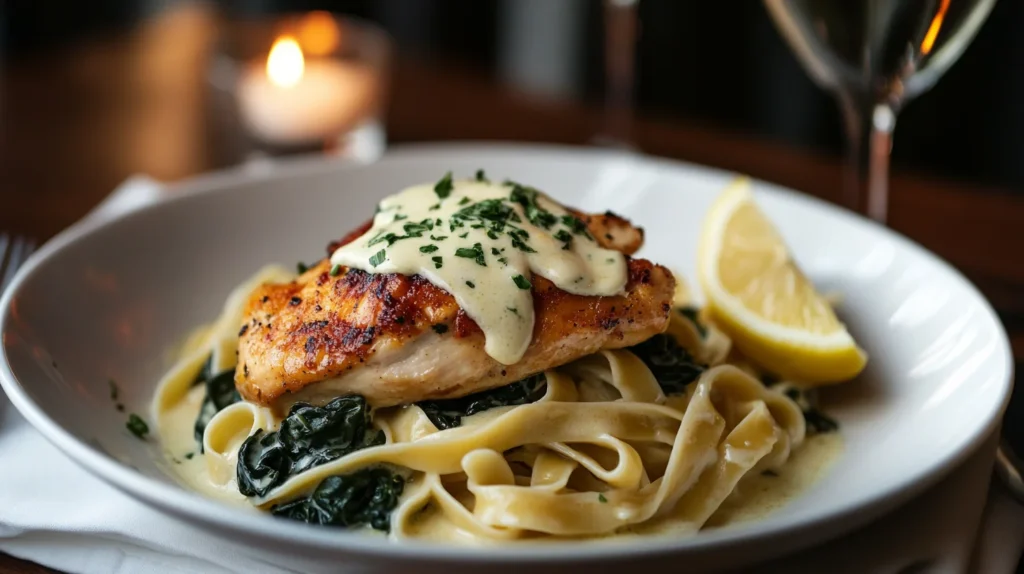
Now that your Creamy Chicken Florentine is bubbling in the skillet, it’s time to think about how to serve it. While the dish is rich and flavorful on its own, pairing it with the right sides or drinks can elevate it into a well-rounded, restaurant-quality meal.
Pasta, Rice, or Bread?
Creamy dishes like this practically beg for a carb base to soak up the luscious sauce. Here are some popular (and delicious) options to consider:
Pasta
- Fettuccine: A classic choice. The flat noodles hold onto the sauce perfectly.
- Penne or Rigatoni: Great for collecting bits of spinach and creamy cheese in the grooves.
- Angel Hair: Lighter and delicate, perfect for an elegant presentation.
When serving with pasta, try tossing it directly into the sauce for even coating and maximum flavor absorption.
Rice
- White Jasmine or Basmati: Simple and fragrant options.
- Wild Rice or Brown Rice: Adds a nutty flavor and more fiber.
- Cauliflower Rice: For a low-carb or keto-friendly option.
Rice makes the dish feel hearty and balances out the creaminess beautifully.
Bread
- Crusty Baguette: Ideal for mopping up leftover sauce.
- Garlic Bread: Adds bold flavor and crunch.
- Ciabatta Rolls: Rustic and absorbent, perfect for plating individual servings.
If you’re short on time or carbs, even a slice of sourdough toast works wonders!
Vegetable Sides for Balance
Because the main dish is rich and creamy, it’s a good idea to add a lighter side to balance things out.
- Steamed or roasted broccoli
- Asparagus spears
- Green beans with lemon and almonds
- Grilled zucchini or bell peppers
These sides enhance the meal’s nutritional value and add texture without overpowering the Florentine flavor.
Wine and Drink Pairings
Pairing the right beverage with Creamy Chicken Florentine enhances the overall experience. The goal is to cut through the creaminess and highlight the dish’s delicate layers of flavor.
Wine Pairings
- Chardonnay (unoaked): Its crispness balances the richness of the sauce.
- Sauvignon Blanc: Dry and citrusy, pairs well with spinach and lemon notes.
- Pinot Grigio: Light and refreshing, especially for summer servings.
Non-Alcoholic Options
- Sparkling water with lemon: Cleanses the palate.
- Iced green tea: Adds an herbal counterpoint to the creamy sauce.
- Cucumber-mint infused water: Cool and refreshing, ideal for a spring or summer meal.
A well-paired drink can transform your Creamy Chicken Florentine into a truly memorable dining experience.
Plating Tips for That Restaurant Look
Want to impress guests—or just treat yourself? Try these plating tips:
- Layer your starch (pasta or rice) first, then place the chicken on top.
- Drizzle the sauce gently over the chicken with a spoon, allowing some to flow onto the sides.
- Garnish with a light sprinkle of fresh parsley, a bit of grated cheese, and a lemon wedge on the side.
- Wipe the plate’s rim with a clean towel before serving for a polished look.
Visual appeal counts, especially when sharing your masterpiece on social media or hosting dinner guests!
Storage and Reheating Tips
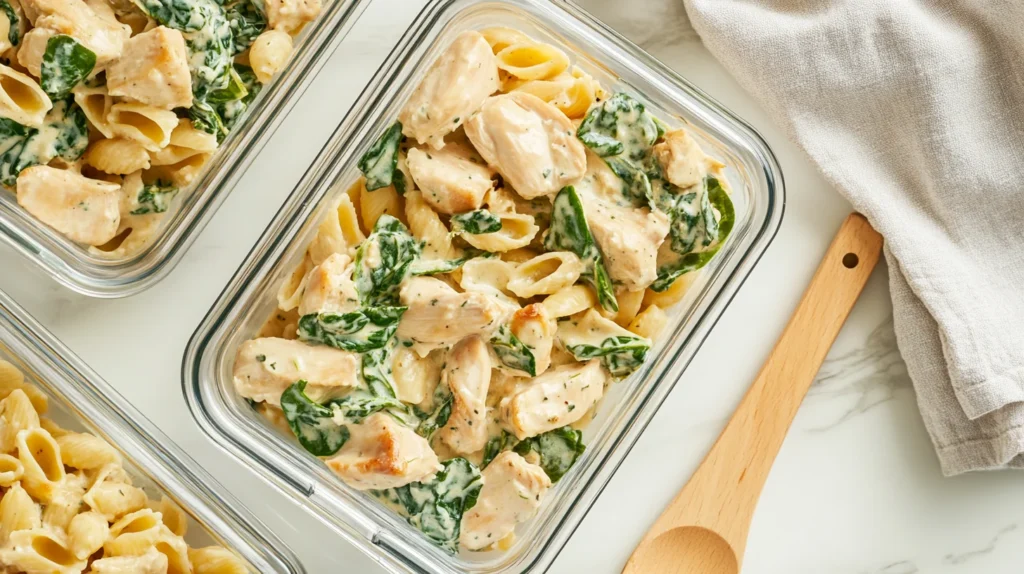
Creamy Chicken Florentine is so good, you’ll want to save the leftovers—or make it ahead for the week. But cream-based sauces require careful handling to preserve texture and flavor.
Refrigeration and Freezing Advice
Refrigeration:
- Store leftovers in an airtight container in the fridge.
- Keeps well for up to 3–4 days.
- Best to store sauce and sides (like pasta or rice) separately to maintain texture.
Freezing:
- Cream sauces can separate or curdle when thawed, so freezing is not ideal.
- If you must freeze it, cool it completely, then store in a freezer-safe container.
- Thaw slowly in the fridge before reheating to preserve consistency.
How to Reheat without Drying Out
- Stovetop Method: Place in a skillet over low heat. Add a splash of broth, milk, or cream to loosen the sauce.
- Microwave Method: Use a microwave-safe dish, cover loosely, and heat in 45-second intervals. Stir between rounds to ensure even heating.
- Avoid overheating to prevent the sauce from breaking or the chicken from drying.
Nutrition Facts and Dietary Considerations
While rich and creamy, Creamy Chicken Florentine can be a balanced meal when portioned properly and served with healthy sides.
| Nutrient | Approximate Amount (Per Serving) |
|---|---|
| Calories | 450–550 kcal |
| Protein | 35–40g |
| Fat | 30–35g |
| Carbs | 8–12g |
| Fiber | 2–3g |
Is It Healthy?
In moderation, yes. It’s packed with protein, and spinach adds iron, calcium, and fiber. The creamy sauce, though rich, can be tweaked for lighter versions using substitutions.
How to Make It More Balanced
- Use light cream or evaporated milk instead of heavy cream.
- Add more veggies like mushrooms, kale, or peas.
- Serve with a side salad for extra nutrients and fiber.
Common Mistakes to Avoid
Even seasoned cooks can make a few missteps. Here are the most common ones—and how to dodge them:
- Overcooking the chicken – Leads to dryness. Use a thermometer!
- Boiling the sauce – Always simmer gently to prevent curdling.
- Adding spinach too early – Wait until the end so it doesn’t get mushy.
- Using low-fat dairy without thickener – Sauce may end up runny.
- Not deglazing the pan – Skipping this loses key flavor from the browned bits.
Avoid these, and your dish will be silky, savory perfection.
Frequently Asked Questions
What is Chicken Florentine made of?
Chicken Florentine is made with boneless chicken breasts or thighs, pan-seared until golden and simmered in a rich, creamy sauce that includes spinach, garlic, cream, and Parmesan cheese. Some versions also use white wine or chicken broth, lemon juice, and Italian herbs for added flavor. The dish is traditionally served over pasta, rice, or with a side of crusty bread to soak up the sauce.
What is the difference between Chicken Florentine and Tuscan chicken?
While both are creamy chicken dishes, the main difference lies in the ingredients and flavor profile.
Chicken Florentine focuses on spinach as a key ingredient and typically features a mild cream-based sauce with a touch of lemon.
Tuscan Chicken, often called “Marry Me Chicken,” includes sun-dried tomatoes, garlic, and Italian herbs, with a slightly more robust and tangy cream sauce. It may also use mozzarella or cream cheese for added richness.
Both are delicious, but Chicken Florentine is more delicate and spinach-centric, while Tuscan chicken is bolder and more tomato-forward.
What is in Florentine sauce?
Florentine sauce is a creamy white sauce primarily made of:
Heavy cream or half-and-half
Parmesan cheese
Garlic
Spinach
White wine or chicken broth (optional)
Lemon juice
Salt, pepper, and sometimes nutmeg
It’s known for its silky texture, gentle seasoning, and the earthy addition of wilted spinach. The sauce pairs wonderfully with chicken, fish, pasta, or eggs.
What makes a dish Florentine?
A dish is called “Florentine” when it features spinach as a primary component. The term comes from Florence, Italy, and was popularized in French cuisine during the Renaissance through Catherine de Medici, who introduced spinach-rich recipes to the French royal kitchen.
So, whether it’s Chicken Florentine, Eggs Florentine, or Fish Florentine, if it includes spinach, it can carry the “Florentine” label.
What does Alla Florentine mean?
“Alla Florentine” is an Italian culinary term that translates to “in the style of Florence.” In practical cooking terms, this means the dish will include spinach, often accompanied by a creamy or cheese-based sauce. So when a dish is prepared alla Florentine, spinach is the signature element, honoring the food traditions of Florence, Italy.
Why are Florentines so expensive?
This question often refers to Florentine biscuits or cookies, which are different from Chicken Florentine. Florentines (the cookies) are luxury confections made with nuts (like almonds or hazelnuts), dried fruits, and often dipped in chocolate. They’re expensive because:
They use high-quality ingredients
The process is labor-intensive
They require precise preparation and baking skills
If referring to the chicken dish at restaurants, Creamy Chicken Florentine can be more costly due to:
Use of premium dairy and cheeses
Labor in pan-searing and sauce-making
Its status as a gourmet-style entrée
Conclusion
Creamy Chicken Florentine is more than just a recipe—it’s a culinary experience. Whether you’re looking for a comforting weeknight dinner or an elegant dish to impress guests, this creamy, spinach-laced chicken delivers every time. With its rich texture, customizable ingredients, and historical charm, it’s a versatile classic that never goes out of style.
So grab your skillet, gather your ingredients, and get ready to enjoy one of the most satisfying meals you’ll ever make. Bon appétit!
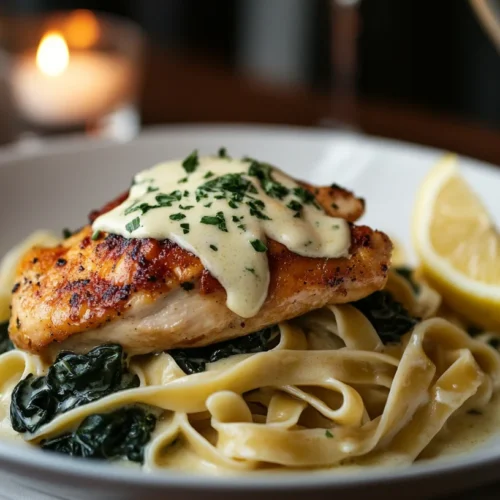
Creamy Chicken Florentine
Equipment
- Large skillet or sauté pan
- Tongs or spatula
- Cutting board and knife
- Measuring cups and spoons
- Whisk
- Wooden spoon
Ingredients
- 4 boneless skinless chicken breasts
- 2 tablespoons olive oil
- Salt and black pepper to taste
- 3 cloves garlic minced
- 1 cup chicken broth or dry white wine
- 1 cup heavy cream
- ½ cup grated Parmesan cheese
- 1 tablespoon lemon juice
- 4 cups fresh baby spinach
- 1 teaspoon Italian seasoning
- 1 tablespoon butter optional, for added richness
- Optional garnish: chopped parsley lemon slices, extra parmesan
Instructions
- Prepare the Chicken:
- Pat the chicken breasts dry and season both sides with salt, pepper, and Italian seasoning.
- Sear the Chicken:
- In a large skillet, heat olive oil (and butter if using) over medium-high heat. Add the chicken and cook for 4–5 minutes per side until golden and cooked through (internal temp 165°F/74°C). Remove and set aside.
- Sauté Garlic:
- Reduce heat to medium. Add minced garlic to the same skillet and cook for 30–60 seconds until fragrant.
- Deglaze the Pan:
- Pour in chicken broth or white wine. Scrape the bottom of the pan to release the flavorful bits and simmer for 2–3 minutes.
- Make the Cream Sauce:
- Stir in the heavy cream and bring to a gentle simmer. Whisk in the Parmesan cheese until fully melted and the sauce thickens.
- Add Spinach & Lemon:
- Add spinach and stir until wilted. Mix in the lemon juice and season with additional salt and pepper if needed.
- Return Chicken to Pan:
- Place the chicken back into the sauce, spoon some over the top, and let it simmer for 3–5 minutes.
- Serve:
- Garnish with parsley, lemon wedges, or extra parmesan. Serve with pasta, rice, or crusty bread.

